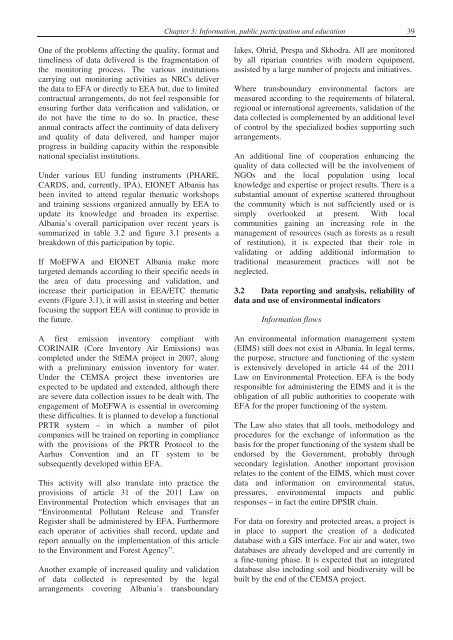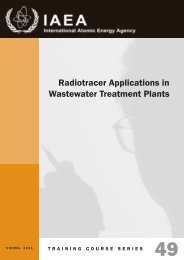Second Environmental Performance Review of Albania
Second Environmental Performance Review of Albania
Second Environmental Performance Review of Albania
You also want an ePaper? Increase the reach of your titles
YUMPU automatically turns print PDFs into web optimized ePapers that Google loves.
Chapter 3: Information, public participation and education39One <strong>of</strong> the problems affecting the quality, format andtimeliness <strong>of</strong> data delivered is the fragmentation <strong>of</strong>the monitoring process. The various institutionscarrying out monitoring activities as NRCs deliverthe data to EFA or directly to EEA but, due to limitedcontractual arrangements, do not feel responsible forensuring further data verification and validation, ordo not have the time to do so. In practice, theseannual contracts affect the continuity <strong>of</strong> data deliveryand quality <strong>of</strong> data delivered, and hamper majorprogress in building capacity within the responsiblenational specialist institutions.Under various EU funding instruments (PHARE,CARDS, and, currently, IPA), EIONET <strong>Albania</strong> hasbeen invited to attend regular thematic workshopsand training sessions organized annually by EEA toupdate its knowledge and broaden its expertise.<strong>Albania</strong>’s overall participation over recent years issummarized in table 3.2 and figure 3.1 presents abreakdown <strong>of</strong> this participation by topic.If MoEFWA and EIONET <strong>Albania</strong> make moretargeted demands according to their specific needs inthe area <strong>of</strong> data processing and validation, andincrease their participation in EEA/ETC thematicevents (Figure 3.1), it will assist in steering and betterfocusing the support EEA will continue to provide inthe future.A first emission inventory compliant withCORINAIR (Core Inventory Air Emissions) wascompleted under the StEMA project in 2007, alongwith a preliminary emission inventory for water.Under the CEMSA project these inventories areexpected to be updated and extended, although thereare severe data collection issues to be dealt with. Theengagement <strong>of</strong> MoEFWA is essential in overcomingthese difficulties. It is planned to develop a functionalPRTR system – in which a number <strong>of</strong> pilotcompanies will be trained on reporting in compliancewith the provisions <strong>of</strong> the PRTR Protocol to theAarhus Convention and an IT system to besubsequently developed within EFA.This activity will also translate into practice theprovisions <strong>of</strong> article 31 <strong>of</strong> the 2011 Law on<strong>Environmental</strong> Protection which envisages that an“<strong>Environmental</strong> Pollutant Release and TransferRegister shall be administered by EFA. Furthermoreeach operator <strong>of</strong> activities shall record, update andreport annually on the implementation <strong>of</strong> this articleto the Environment and Forest Agency”.Another example <strong>of</strong> increased quality and validation<strong>of</strong> data collected is represented by the legalarrangements covering <strong>Albania</strong>’s transboundarylakes, Ohrid, Prespa and Skhodra. All are monitoredby all riparian countries with modern equipment,assisted by a large number <strong>of</strong> projects and initiatives.Where transboundary environmental factors aremeasured according to the requirements <strong>of</strong> bilateral,regional or international agreements, validation <strong>of</strong> thedata collected is complemented by an additional level<strong>of</strong> control by the specialized bodies supporting sucharrangements.An additional line <strong>of</strong> cooperation enhancing thequality <strong>of</strong> data collected will be the involvement <strong>of</strong>NGOs and the local population using localknowledge and expertise or project results. There is asubstantial amount <strong>of</strong> expertise scattered throughoutthe community which is not sufficiently used or issimply overlooked at present. With localcommunities gaining an increasing role in themanagement <strong>of</strong> resources (such as forests as a result<strong>of</strong> restitution), it is expected that their role invalidating or adding additional information totraditional measurement practices will not beneglected.3.2 Data reporting and analysis, reliability <strong>of</strong>data and use <strong>of</strong> environmental indicatorsInformation flowsAn environmental information management system(EIMS) still does not exist in <strong>Albania</strong>. In legal terms,the purpose, structure and functioning <strong>of</strong> the systemis extensively developed in article 44 <strong>of</strong> the 2011Law on <strong>Environmental</strong> Protection. EFA is the bodyresponsible for administering the EIMS and it is theobligation <strong>of</strong> all public authorities to cooperate withEFA for the proper functioning <strong>of</strong> the system.The Law also states that all tools, methodology andprocedures for the exchange <strong>of</strong> information as thebasis for the proper functioning <strong>of</strong> the system shall beendorsed by the Government, probably throughsecondary legislation. Another important provisionrelates to the content <strong>of</strong> the EIMS, which must coverdata and information on environmental status,pressures, environmental impacts and publicresponses – in fact the entire DPSIR chain.For data on forestry and protected areas, a project isin place to support the creation <strong>of</strong> a dedicateddatabase with a GIS interface. For air and water, twodatabases are already developed and are currently ina fine-tuning phase. It is expected that an integrateddatabase also including soil and biodiversity will bebuilt by the end <strong>of</strong> the CEMSA project.
















